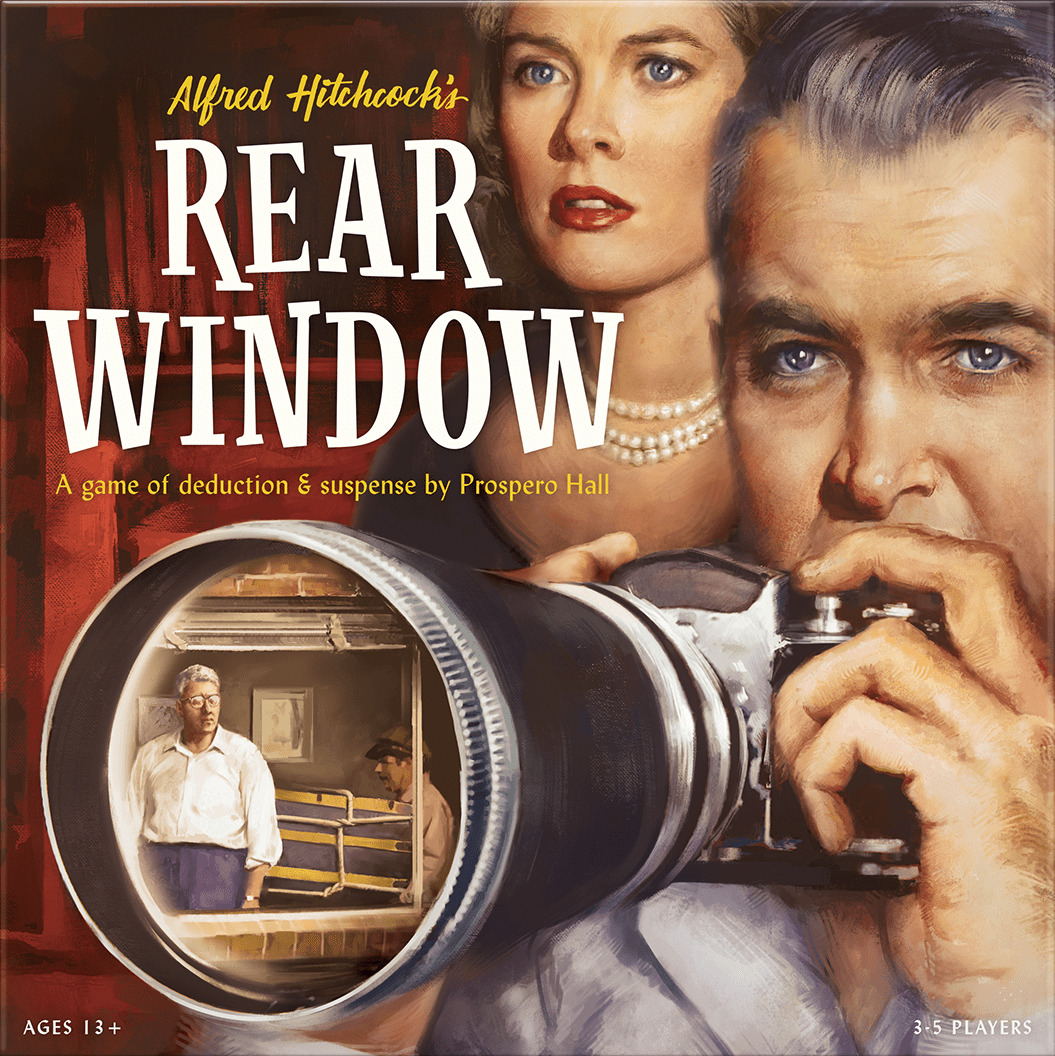“Intelligence. Nothing has caused the human race so much trouble as intelligence.” So said Stella in the 1954 Hitchcock classic film Rear Window, which lends its name and premise to this new board game from Funko Games. And Stella was right, intelligence is going to cause you no end of trouble in this game. One person plays the role of Hitchcock as Director, giving out clues, while the rest of the players act as Watchers, staring at the windows of the apartment block, trying to figure out who lives in which apartment, what trait that person has, and whether or not a murder has been committed! It’s as much fun to lead the dance as the Director, as it is to peek through windows and figure it all out.

If you’ve played other deduction games before, this might all sound familiar. Dishing out clues to help the rest of the table figure out the identities – ringing any bells? That’s right folks, Mysterium. Rear Window shares a lot of design DNA with Mysterium, but there are some small, but very important differences between the two.
“Well, that’s fine, Stella. Now would you fix me a sandwich please?”
The biggest difference between those two games is the goal of the game. In Mysterium, it’s always a cooperative game. All of the players win or lose together, so it’s always in everybody’s best interests to give good clues. In Rear Window, it’s usually the same. In order to win the Director needs the Watchers to correctly identify the four people involved, and their individual traits. To give them clues, they assign cards from their hand to the various windows on the board, hoping that the Watchers feed off the clues on each card you want them to notice, instead of the ones they invariably notice instead…

Earlier in this review though, you might have noticed the word ‘murder’, and if you’ve seen the film you’ll know that murder plays a big part. In the game adaptation the Watchers hand the Director 12 trait tiles and a murder tile. The tiles are shuffled and four of them are assigned – in secret, behind a screen – to each of the four apartments. You might think a 1-in-13 chance is low when it comes to drawing the murder tile, but the maths is more like 4-in-13, or closer to 1-in-3, so it happens quite often.
If and when a murder tile comes into play, the game is no longer cooperative. It’s now competitive. If the Watchers guess at least seven of the eight pieces of information, and guess where the murder happened, they win. For the Director to win when someone’s been offed, they have to make sure the Watchers guess at least six pieces of information and have them not guess where the murder happened. It’s a fine tightrope to tread.

It all goes to make Rear Window so tricky to play at first because as a Watcher, you have no idea whether a murder has happened. You’re working in good faith, you wonderful person you, because that’s all you have to go on at first. Figuring out whether there’s been a murder is tricky. Are the Director’s clues intentionally misleading so you don’t guess somebody’s done a bit of murdering, or are they just a bit crap at giving clues? Tricky…
“A murderer would never parade his crime in front of an open window.”
The other big departure from Mysterium is the art direction for the cards. Mysterium is like Dixit, in that the cards are often surreal, with colours and images which don’t normally belong together. In Rear Window, the cards all feature people and/or places from each apartment. You’ll see very specific people on the cards, matching the people you’re trying to guess. On the one hand, this is great. If you want to tell them Miss Torso is in apartment A, you can just put a card with her in that slot on the board. The difficulty comes when – as Director – you have a hand of cards which don’t feature the people you want to point to. What then?

This is where things get equally frustrating for the Director and the Watchers. You’ll play a card to a slot because you have to, so you’ll hope they guess other features on the card instead. Maybe the Director doesn’t want you to focus on the person, they’re more interested in the food in the background, trying to steer you toward guessing that person has the Gourmand trait. The Director can play a couple of cards each round face-down, which is great when you’re the Director and don’t want to give false clues, but it can also draw suspicion from the Watchers. “Is she playing that card face-down because maybe they’re the murderer, and she doesn’t want us to know?”.
It doesn’t take much to get suspicions roused, I can tell you that much.
Final thoughts
Let’s do the quick and easy bit first. If you like Mysterium, you’ll love Rear Window. The core gameplay is very much the same, but the addition of a semi-cooperative goal, and the never knowing which goal is in play until the end of the game, is awesome. I’ve played with some people who didn’t get on with it as well, but some of that I’m sure came down to the fact that on their very final action of the game, they felt like it was a toss-up between murder and one of three remaining traits. Repeated play is definitely rewarded, as is having a group who might enjoy this sort of game. It’s all about abstract communication, not strategy.
I really like the art direction in the game. It stays true to the feeling and style of the film, and it’s functional at the same time as being really nice. I don’t often make much of a fuss about the art in a game, but in the case of Rear Window the whole game revolves around the artwork, so it matters. We’ve seen a few film tie-ins over the last few years, but the majority of them feel more like a couple of smaller games bolted together. Top Gun with its mixture of a beach volleyball game combined with a dog-fighting one. Jaws with the Island side of the board before the big battle with the angry fish on the rear. Interestingly, both of those games also came from the design studio of Prospero Hall, but Rear Window feels more polished and more refined. It could have been made without the Rear Window name and theming and been just as good.
I’ve not mentioned a few of the other things in the box. For instance, the tiles that the Watchers can use to sneak looks at or replace face-down cards, or get the Director to add a pointer to a card to show which thing to focus on (or not, if you’re feeling particularly devious). There are additional trait tiles which let you add a second person to an apartment along with some kind of relationship between the occupants, just to really spice things up. Rear Window is a very, very good game, and as much as I hate it when Youtube channels make their “this game killed this other game” videos, I can’t see Mysterium getting much more play for me now. Rear Window is like Mysterium 1.5 and it’s great.
Review copy kindly provided by Funko Games. Thoughts and opinions are my own.
Enjoying this article? Consider supporting me.

Rear Window (2022)
Design: Prospero Hall
Publisher: Funko Games
Art: uncredited
Players: 3-5
Playing time: 45 mins


